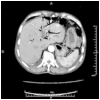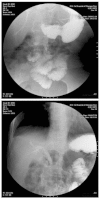Peptic ulcers accompanied with gastrointestinal bleeding, pylorus obstruction and cholangitis secondary to choledochoduodenal fistula: A case report
- PMID: 26870237
- PMCID: PMC4727103
- DOI: 10.3892/ol.2015.3908
Peptic ulcers accompanied with gastrointestinal bleeding, pylorus obstruction and cholangitis secondary to choledochoduodenal fistula: A case report
Abstract
Peptic ulcers are an extremely common condition, usually occurring in the stomach and proximal duodenum. However, cases of peptic ulcers accompanied with multiple complications are extremely rare and hard to treat. The present case reinforces the requirement for the early recognition and correct treatment of peptic ulcers accompanied with multiple complications. A 67-year-old man presented with recurrent abdominal pain, fever and melena. The laboratory results showed anemia (hemoglobin 62 g/l) and hypoproteinemia (23 g/l). Abdominal imaging examinations revealed stones in the gallbladder and right liver, with air in the dilated intrahepatic and extrahepatic bile ducts. Endoscopic retrograde cholangiopancreatography failed due to a deformed pylorus. The patient was finally diagnosed with peptic ulcers accompanied with gastrointestinal (GI) bleeding, pylorus obstruction and cholangitis secondary to a choledochoduodenal fistula during an emergency pancreatoduodenectomy, which was performed due to a massive hemorrhage of the GI tract. The patient recovered well after the surgery.
Keywords: cholangitis; choledochoduodenal fistula; duodenal ulcer; gastric ulcer; gastrointestinal bleeding; pyloric obstruction.
Figures
Similar articles
-
A Complicated Peptic Ulcer With Bleeding, Gastric Outlet Obstruction, and Choledochoduodenal Fistula.Cureus. 2020 Oct 26;12(10):e11189. doi: 10.7759/cureus.11189. Cureus. 2020. PMID: 33269120 Free PMC article.
-
The clinical presentations of ectopic biliary drainage into duodenal bulbus and stomach with a thorough review of the current literature.BMC Gastroenterol. 2010 Jan 12;10:2. doi: 10.1186/1471-230X-10-2. BMC Gastroenterol. 2010. PMID: 20064279 Free PMC article. Review.
-
An Unusual Case of Choledochoduodenal Fistula Secondary to Peptic Ulcer Presenting With Cholangitis and Pneumobilia.Cureus. 2023 Jun 25;15(6):e40915. doi: 10.7759/cureus.40915. eCollection 2023 Jun. Cureus. 2023. PMID: 37496537 Free PMC article.
-
Choledochoduodenal fistula at the anterior wall of the duodenal bulb: a rare complication of duodenal ulcer.Hepatogastroenterology. 1999 Jan-Feb;46(25):261-4. Hepatogastroenterology. 1999. PMID: 10228804
-
Peptic ulcer disease complicated with choledocho-duodenal fistula and gastro-intestinal bleeding: a case report and review of the literature.Front Surg. 2023 Jun 20;10:1206828. doi: 10.3389/fsurg.2023.1206828. eCollection 2023. Front Surg. 2023. PMID: 37409067 Free PMC article. Review.
Cited by
-
A Complicated Peptic Ulcer With Bleeding, Gastric Outlet Obstruction, and Choledochoduodenal Fistula.Cureus. 2020 Oct 26;12(10):e11189. doi: 10.7759/cureus.11189. Cureus. 2020. PMID: 33269120 Free PMC article.
-
In vivo acute toxicity and anti-gastric evaluation of a novel dichloro Schiff base: Bax and HSP70 alteration.Acta Biochim Biophys Sin (Shanghai). 2020 Jan 2;52(1):26-37. doi: 10.1093/abbs/gmz140. Acta Biochim Biophys Sin (Shanghai). 2020. PMID: 31889181 Free PMC article.
-
Choledochoduodenal Fistula Secondary to Peptic Ulcer Disease: A Case Report.Am J Case Rep. 2019 Mar 27;20:398-401. doi: 10.12659/AJCR.915600. Am J Case Rep. 2019. PMID: 30914631 Free PMC article.
-
Non-perforated peptic ulcer disease: multidetector CT findings, complications, and differential diagnosis.Insights Imaging. 2017 Oct;8(5):455-469. doi: 10.1007/s13244-017-0562-5. Epub 2017 Jul 4. Insights Imaging. 2017. PMID: 28677101 Free PMC article. Review.
References
-
- University of Michigan Health System. www.cme.med.umich.edu/pdf/guideline/PUD05.pdf. [May 04;2007 ];Peptic ulcer disease. Accessed.
-
- Barkun AN, Bardou M, Kuipers EJ, Sung J, Hunt RH, Martel M, Sinclair P. International Consensus Upper Gastrointestinal Bleeding Conference Group: International consensus recommendations on the management of patients with nonvariceal upper gastrointestinal bleeding. Ann Intern Med. 2010;152:101–113. doi: 10.7326/0003-4819-152-2-201001190-00009. - DOI - PubMed
-
- Laursen SB, Jørgensen HS, de Muckadell Schaffalitzky OB. Danish Society of Gastroenterology and Hepatology: Management of bleeding gastroduodenal ulcers. Dan Med J. 2012;59:C4473. - PubMed
LinkOut - more resources
Full Text Sources
Other Literature Sources


